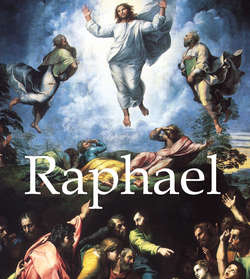Читать книгу Raphael - Eugène Müntz - Страница 6
На сайте Литреса книга снята с продажи.
Raphael Returns to Urbino
ОглавлениеMeanwhile, his lengthy stay in Umbria had not caused Raphael to forget his native city, his beloved Urbino. Once he had fulfilled his obligations in Perugia and in Città di Castello, he resolved to go and see his relatives, his uncle Simon and the Montefeltro family who ruled the Duchy of Urbino, to whom his father had been a friend much more than a subject. This trip took place in 1504, perhaps on his return from Siena.
Madonna and Child with an Angel and the Infant Saint John, known as Madonna Terranuova
1505
Oil on poplar wood, diameter: 88.5 cm
Staatliche Museen zu Berlin, Berlin
Considering only painting, the court of Urbino supplied Raphael with varied and picturesque subjects. The learned conversations presided over by Duchess Elisabetta, the theatrical performances, the frequent references to classical Antiquity, animated his brush by turns.
But the citizens of Urbino had even stronger sentiments in their hearts. In the wake of cruel hardships such as the invasion of the duchy by the Borgias, and after a deliverance they had scarcely dared hope for, patriotism was in the air.
The Madonna and Child Enthroned with Saint John the Baptist and Saint Nicholas of Bari, known as Madonna Ansidei
1505
Oil on poplar wood, 216.8 × 147.6 cm
The National Gallery, London
Raphael could not have been unaware of such things. There is no doubt that in his Saint George and Saint Michael, both painted for Guidobaldo da Montefeltro, he wished to symbolise the defeat of Cesare Borgia and the triumph of the Montefeltros. These free and bold allegories are part of the master’s genius. Narrating, in an official style, the combats and the exploits of his patrons seemed to him unworthy. In his eyes, the struggles of his contemporaries needed to be raised to an epic level, translated into expressions meant to live across the centuries.
Madonna and Child, known as Little Cowper Madonna
c. 1505
Oil on wood, 59.5 × 44 cm
Widener Collection, National Gallery of Art, Washington, D.C.
The Saint George is a masterpiece of composition, but it is also a masterpiece of colour. Raphael demonstrates, through the judicious choice of hues and through their vigorous and precise repetitions, the extent to which the painter and the draughtsman are combined in his art. There is nothing more delicate and harmonious than this painting in which, for all of that, no detail is sacrificed. The red saddle contrasts strikingly with the magnificent white coat of the horse; it makes, in turn, the most picturesque contrast against the steel armour of the saint.
Portrait of Agnolo Doni
1505–1506
Oil on wood, 65 × 47.7 cm
Palazzo Pitti, Galleria Palatina e Appartamenti Reali, Florence
The red and white sections of the lance add a lively, bright note to the subdued tones of the landscape; they inject into the whole a most striking sense of energy.
